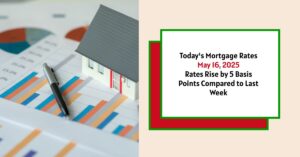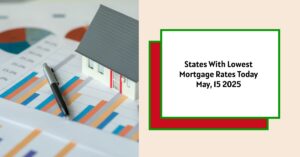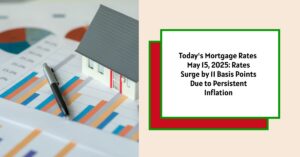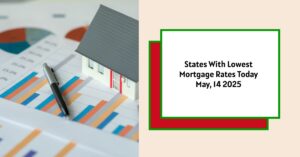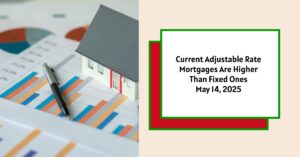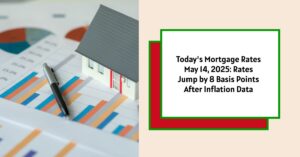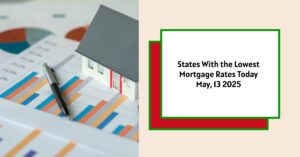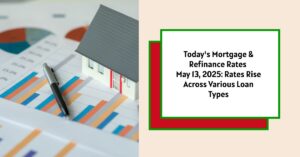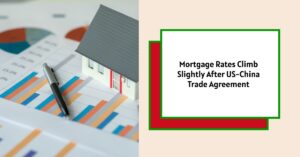As of May 16, 2025, mortgage rates have slightly increased this week but remain lower compared to the same time last year. The 30-year fixed mortgage rate now sits at 6.85%, while the 15-year fixed rate is at 6.13%. Despite this recent uptick in rates, buyers may find comfort knowing that these figures are significantly lower than last year's averages, making it a more favorable time for potential homebuyers.
Today's Mortgage Rates – May 16, 2025: Rates Are Up as Compared to Last Week
Key Takeaways
- Mortgage Rates: 30-year fixed at 6.85%; 15-year fixed at 6.13%.
- Refinance Rates: 30-year refinance at 6.99%; 15-year refinance at 6.35%.
- Year-over-Year Comparison: Rates decreased from last year, providing better opportunities for homebuyers.
- Market Influence: Recent rates impacted by inflation expectations due to tariffs.
- Future Outlook: Economists predict rates may stabilize or decrease slightly in the coming months.
Current Mortgage Rates
Today’s mortgage rates show an increase across various term lengths, primarily influenced by market conditions. Let's take a closer look at the current mortgage and refinance rates from Zillow.
| Loan Type | Current Rate (%) |
|---|---|
| 30-Year Fixed | 6.85% |
| 20-Year Fixed | 6.34% |
| 15-Year Fixed | 6.13% |
| 5/1 Adjustable | 7.18% |
| 7/1 Adjustable | 7.38% |
| 30-Year VA | 6.33% |
| 15-Year VA | 5.76% |
| 5/1 VA | 6.49% |
These rates reflect national averages and may vary based on the lender and individual borrower qualifications, including credit score, down payment, and overall financial profile.
Current Mortgage Refinance Rates
Refinancing remains an option for many homeowners looking to lower their mortgage payments or cash out some equity. Here's how today's refinance rates compare:
| Refinance Loan Type | Current Rate (%) |
|---|---|
| 30-Year Fixed | 6.99% |
| 20-Year Fixed | 6.56% |
| 15-Year Fixed | 6.35% |
| 5/1 Adjustable | 7.26% |
| 7/1 Adjustable | 7.22% |
| 30-Year VA | 6.46% |
| 15-Year VA | 5.94% |
| 5/1 VA | 6.39% |
This data allows borrowers to assess refinancing options based on current market rates. It is essential for homeowners considering refinancing to evaluate rates closely, as they may significantly impact monthly payments.
Understanding Mortgage Interest Rates
Mortgage interest rates are essentially the cost of borrowing money to purchase a home. Expressed as a percentage, they can significantly influence your monthly payments and the total payoff amount over the life of a loan.
Fixed vs. Adjustable Rates
- Fixed-Rate Mortgages: These loans maintain the same interest rate throughout the term, providing predictability. Common terms include 30-year and 15-year options. For a 30-year fixed mortgage, the borrower’s monthly payments will remain unchanged, allowing homeowners to budget effectively.
- Adjustable-Rate Mortgages (ARMs): These rate options usually start with a lower initial rate that adjusts after a specified period, such as 5 or 7 years. For example, in a 5/1 ARM, the rate remains fixed for the first five years and then adjusts annually based on market conditions. Borrowers need to carefully weigh the pros and cons of variable interest rates, as fluctuations could affect long-term financial stability.
Market Trends and Influences
Over the past few months, interest rates have been responsive to several factors, notably inflationary pressures brought about by tariff policies. Recent increases, particularly the five basis point jump in 30-year fixed rates, reflect a market reaction to economic signals.
The Role of Tariffs and Inflation
Expectations that tariffs will drive inflation higher have contributed to the slight rise in mortgage rates. Economic forecasts indicate that the Federal Reserve may need to keep interest rates elevated to counteract inflation, which could limit the extent to which mortgage rates drop in the short term.
In a recent speech, Fed Chair Jerome Powell expressed concern that inflation might soon become more volatile, which could keep rates elevated longer than anticipated. Tariffs on goods now affect construction materials, increasing the overall costs for builders and, consequently, the prices of new homes. Homebuyers may face competitive pricing in the market, making home purchases potentially costlier than in the previous year.
Current Trends Compared to Last Year
Looking back to May 2024, it’s encouraging that mortgage rates have decreased significantly:
- The 30-year fixed rate one year ago was 7.13%, indicating a decrease of 28 basis points.
- The 15-year fixed rate fell from 6.59%, showing a decrease of 46 basis points.
This drop in rates enhances affordability for a broader array of homebuyers, making it a more favorable time to enter the housing market. The overall economy also plays a role, as potential buyers may take advantage of lower rates before any significant adjustments occur.
Expert Forecasts for Mortgage Rates
Economists closely monitor and predict mortgage rate trends. Both Fannie Mae and the Mortgage Bankers Association (MBA) have provided their forecasts for the upcoming months. Here’s a summary based on their projections for 30-year fixed-rate mortgages:
| Forecaster | Q2/25 (%) | Q3/25 (%) | Q4/25 (%) | Q1/26 (%) |
|---|---|---|---|---|
| Fannie Mae | 6.5% | 6.3% | 6.2% | 6.1% |
| MBA | 7.0% | 6.8% | 6.7% | 6.6% |
The projections suggest a gradual decrease in rates over the rest of 2025, though these forecasts are subject to national and global economic conditions. While the forecasts indicate potential relief for buyers, fluctuations in the market mean that both economic growth and inflation trends will continue to influence the housing landscape.
Read More:
Mortgage Rates Trends as of May 15, 2025
Dave Ramsey Predicts Mortgage Rates Will Probably Drop Soon in 2025
Future of Mortgage Rates Post-Fed Decision: Will Rates Drop?
Fed's Decision Signals Mortgage Rates Won't Go Down Significantly
How Average Rates Affect Monthly Payments
Understanding how these rates translate to actual monthly payments is crucial for any homebuyer or homeowner considering refinancing. Here’s a quick example using the 30-year fixed rate of 6.85% for a mortgage of $300,000:
- Monthly Principal and Interest: At a 6.85% interest rate, the monthly payment (excluding taxes and insurance) would be approximately $1,965.
- Over the course of the full 30 years, this loan would yield total interest payments nearing $682,000.
In comparison, had you locked in the lower rate of 6.50%, the monthly payment would be about $1,898, resulting in roughly $612,000 in interest over the life of the loan. This exemplifies how even slight rate differences can lead to substantial savings.
The Bigger Picture: Economic and Social Implications
The implications of mortgage rates extend beyond individual buyers, affecting the broader economy, including employment in construction and real estate sectors. With mortgage rates being a significant contributor to housing demand, fluctuations will have ripple effects throughout the economic fabric.
Higher rates can slow down the housing market, resulting in less new home construction, impacting jobs in related fields. Conversely, lower rates typically stimulate housing demand, driving homebuilders to meet new demand and potentially fostering job creation within the sector.
As potential homebuyers navigate these fluctuations, many are also weighing their options regarding rental versus buying. Increased mortgage rates might deter some from purchasing, pushing them into rental markets, subsequently increasing rental prices due to heightened demand.
Summary:
While it’s true that mortgage rates increased slightly this week, they are still competitively lower compared to last year's figures. The housing market remains active, driven by buyers' desire to capitalize on favorable pricing from the last year. However, potential buyers should remain aware of market fluctuations and strategize accordingly, especially with influences from macroeconomic changes. The coming months will be key for the housing market, as the balance of inflation concerns, economic growth narratives, and Federal Reserve actions continues to play out.
Understanding today’s mortgage landscape is more critical than ever for buyers and homeowners alike. As economic conditions evolve, the need for informed decision-making remains paramount in the home buying process.
Invest Smarter in a High-Rate Environment
With mortgage rates remaining elevated this year, it's more important than ever to focus on cash-flowing investment properties in strong rental markets.
Norada helps investors like you identify turnkey real estate deals that deliver predictable returns—even when borrowing costs are high.
HOT NEW LISTINGS JUST ADDED!
Connect with a Norada investment counselor today (No Obligation):
(800) 611-3060
Also Read:
- Will Mortgage Rates Go Down in 2025: Morgan Stanley's Forecast
- Expect High Mortgage Rates Until 2026: Fannie Mae's 2-Year Forecast
- Mortgage Rate Predictions 2025 from 4 Leading Housing Experts
- Mortgage Rates Forecast for the Next 3 Years: 2025 to 2027
- 30-Year Mortgage Rate Forecast for the Next 5 Years
- 15-Year Mortgage Rate Forecast for the Next 5 Years
- Why Are Mortgage Rates Going Up in 2025: Will Rates Drop?
- Why Are Mortgage Rates So High and Predictions for 2025
- Will Mortgage Rates Ever Be 3% Again in the Future?
- Mortgage Rates Predictions for Next 2 Years
- Mortgage Rate Predictions for Next 5 Years
- Mortgage Rate Predictions: Why 2% and 3% Rates are Out of Reach
- How Lower Mortgage Rates Can Save You Thousands?
- How to Get a Low Mortgage Interest Rate?
- Will Mortgage Rates Ever Be 4% Again?
